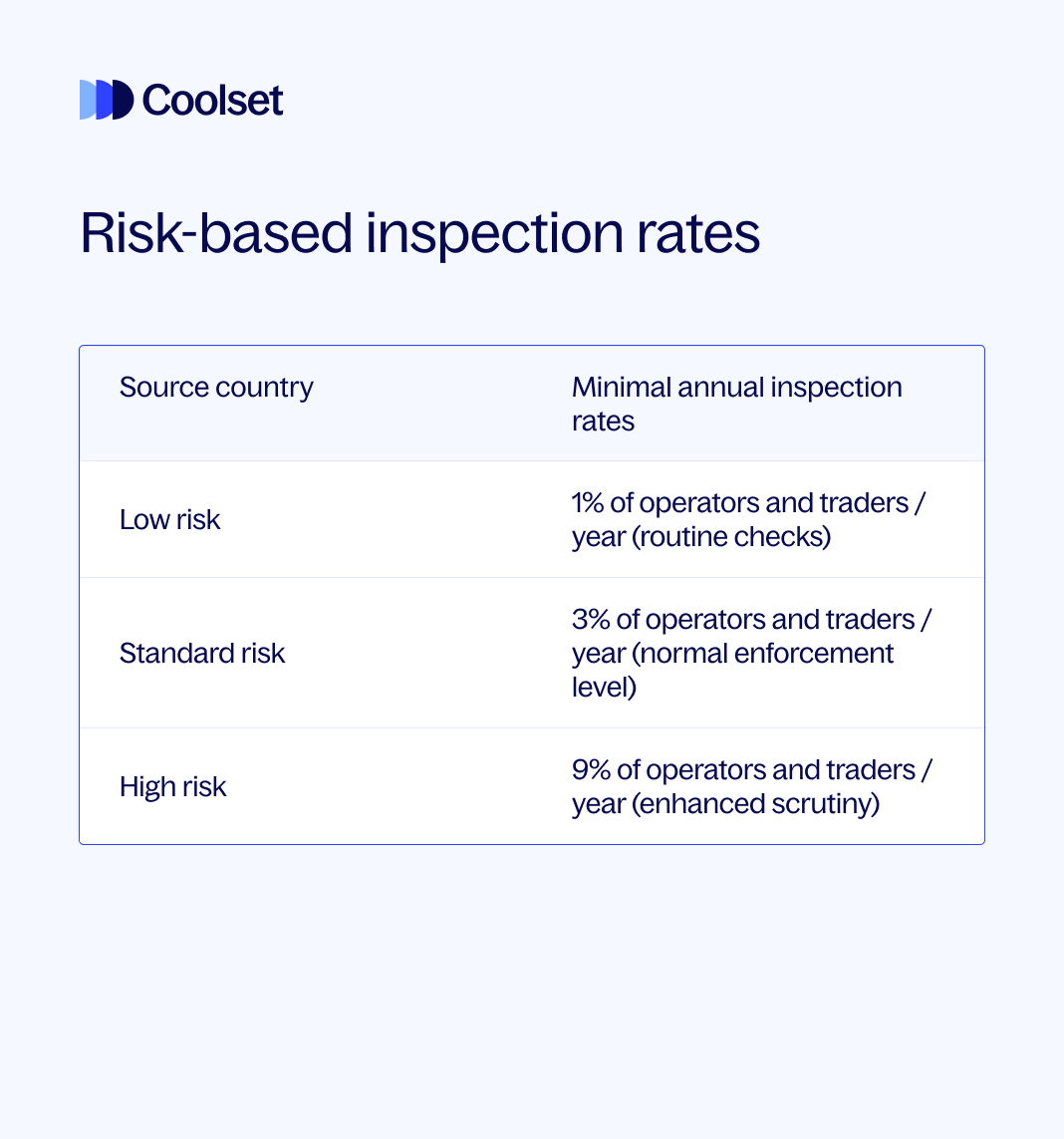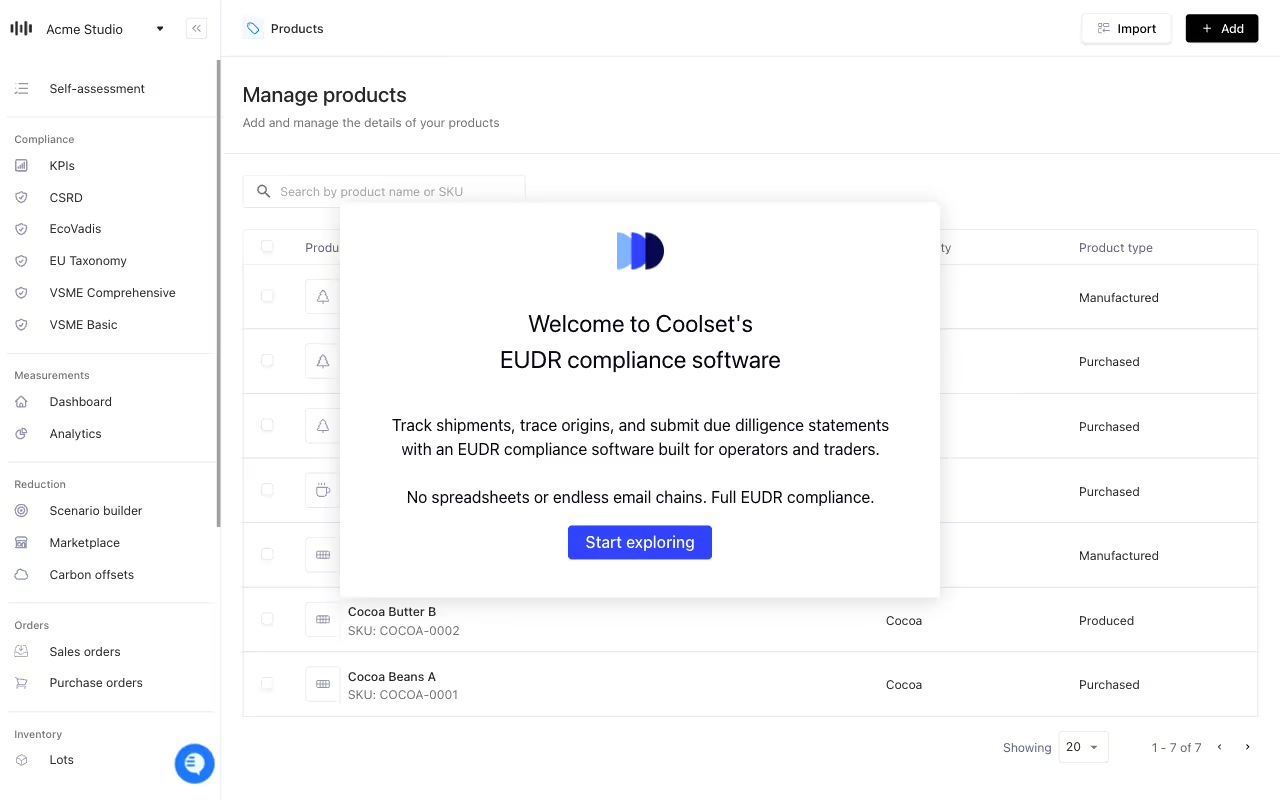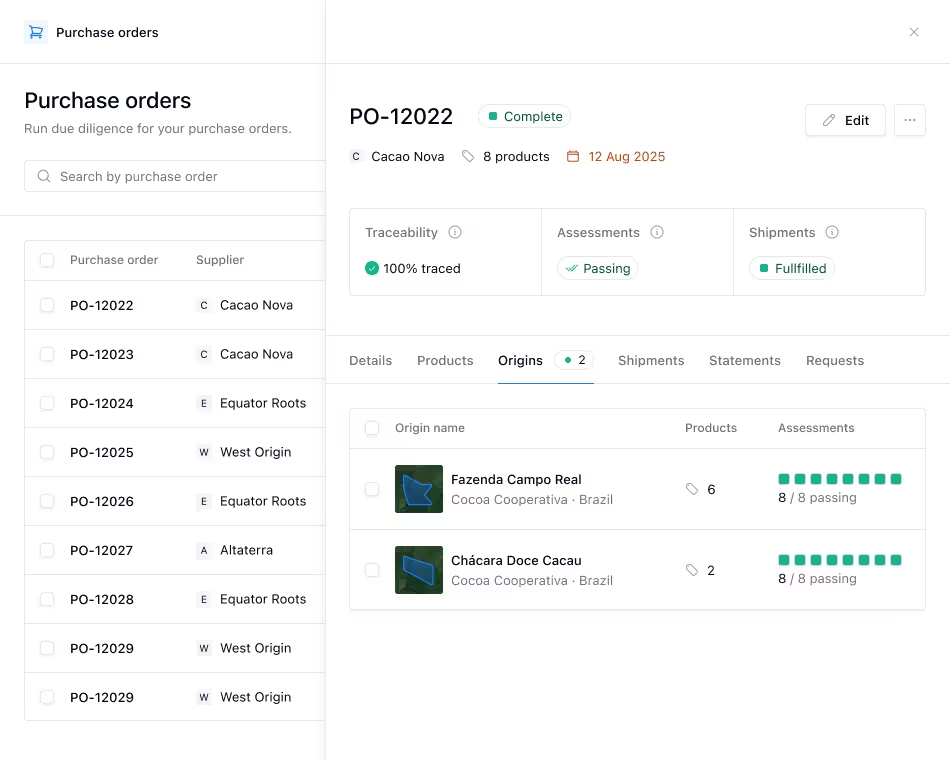Disclaimer: New EUDR developments - December 2025
In November 2025, the European Parliament and Council backed key changes to the EU Deforestation Regulation (EUDR), including a 12‑month enforcement delay and simplified obligations based on company size and supply chain role.
Key changes proposed:
These updates are not yet legally binding. A final text will be confirmed through trilogue negotiations and formal publication in the EU’s Official Journal. Until then, the current EUDR regulation and deadlines remain in force.
We continue to monitor developments and will update all guidance as the final law is adopted.
Disclaimer: 2026 Omnibus changes to CSRD and ESRS
In December 2025, the European Parliament approved the Omnibus I package, introducing changes to CSRD scope, timelines and related reporting requirements.
As a result, parts of this article may no longer fully reflect the latest regulatory position. We are currently reviewing and updating our CSRD and ESRS content to align with the new rules.
Key changes include:
We continue to monitor regulatory developments closely and will update this article as further guidance and implementation details are confirmed.
Die EU-Entwaldungsverordnung (EUDR) führt mehr als nur neue Nachhaltigkeitsregeln ein. Sie bringt ein robustes Durchsetzungsrahmenwerk mit, das die Einhaltung aktiv überwacht. Für Unternehmen ist das Verständnis der Durchsetzung genauso wichtig wie das Verständnis der Anforderungen.
Im November 2025 unterstützten das Europäische Parlament und der Rat einen Vorschlag zur Verzögerung der EUDR-Durchsetzung um 12 Monate. Bei Annahme würde die Verordnung ab dem 30. Dezember 2026 für große und mittlere Betreiber und ab dem 30. Juni 2027 für kleine und Mikro-Betreiber gelten. Diese Änderungen sollen im Dezember 2025 durch Trilogverhandlungen bestätigt werden.
Das Ignorieren von Durchsetzungsmechanismen kann zu Beschlagnahmungen, finanziellen Strafen und Reputationsrisiken führen. Aber das Wissen, wie die Compliance in der Praxis bewertet wird, hilft Unternehmen, Due-Diligence-Systeme zu entwickeln, die von Anfang an der Prüfung standhalten.
In diesem Artikel erklären wir, wie die EUDR-Durchsetzung funktioniert: Von der Rolle der Zoll- und nationalen Regulierungsbehörden bis zum Konzept der begründeten Bedenken und den Strafen bei Nichteinhaltung. Wir teilen auch praktische Schritte, die Unternehmen unternehmen können, um das Durchsetzungsrisiko durch starke Due Diligence und intelligente Tools zu reduzieren.
{{custom-cta}}
Die EUDR-Durchsetzung beschränkt sich nicht auf nachträgliche Audits oder passive Papierkontrollen. Es ist ein strukturiertes, datengetriebenes Verfahren, das beginnt, sobald Waren in die EU gelangen, und weit über die Zollabfertigung hinausgeht. Für Unternehmen, die ihre Due-Diligence-Systeme vorbereiten, ist das Verständnis, wie die Compliance in der Praxis überprüft wird, entscheidend.
Zuständige Behörden: Die Frontlinie der Durchsetzung
Jeder EU-Mitgliedstaat hat eine oder mehrere zuständige Behörden benannt, die für die Durchsetzung der EUDR verantwortlich sind. Diese nationalen Regulierungsbehörden, oft mit Umwelt-, Landwirtschafts- oder Forstministerien verbunden, überwachen, ob Betreiber ihren Due-Diligence-Verpflichtungen nachkommen. Sie haben die rechtliche Befugnis, zu prüfen, zu untersuchen und gegebenenfalls Strafen zu verhängen.
Im Gegensatz zu geplanten Finanzprüfungen können EUDR-Inspektionen unangekündigt erfolgen. Zuständige Behörden können Dokumentationen anfordern, Systeme überprüfen oder Einrichtungen ohne Vorankündigung inspizieren.
Diese Behörden arbeiten auch in Abstimmung mit dem Zoll und ihren Kollegen in der gesamten EU. Wenn in einem Land nicht konforme Waren entdeckt werden, werden die Informationen geteilt, um den Eintritt anderswo zu verhindern und ein vernetztes Durchsetzungsnetzwerk im Binnenmarkt zu schaffen.
Tipp: Sie wissen nicht, wer Ihre zuständige Behörde ist?
Die Europäische Kommission führt eine offizielle Liste der zuständigen Behörden nach Ländern. Überprüfen Sie Ihre hier.
Der Zoll ist Ihr erster Ansprechpartner
Die EUDR-Durchsetzung beginnt nicht bei den Regulierungsbehörden, sondern an der Grenze. Jede Sendung von betroffenen Waren muss mit einer Due-Diligence-Erklärung (DDS) verknüpft sein. Zollbehörden überprüfen diese DDS jetzt als Teil des Standardimport- oder Exportdeklarationsprozesses.
Wenn eine DDS fehlt, unvollständig ist oder mit einer Hochrisikoquelle oder einem markierten Betreiber verbunden ist, kann der Zoll die Freigabe verzögern oder aussetzen, bis eine zuständige Behörde ihre Überprüfung abgeschlossen hat. Diese frühzeitige Durchsetzung verhindert, dass nicht konforme Waren überhaupt in den EU-Markt gelangen.
Heute erfolgt diese Koordination über nationale Kontaktstellen und Zollsysteme. Aber dieser Prozess entwickelt sich weiter. Bis Juni 2028 wird die EU eine vollständig integrierte Single Window-Umgebung einführen, eine automatisierte Schnittstelle, die nationale Zollsysteme mit der EUDR-Datenbank verbindet. Sobald sie eingerichtet ist, erhalten Zollbeamte Echtzeitwarnungen, wenn eine DDS fehlt oder mit Risikofaktoren verbunden ist, was die Durchsetzung vereinfacht und bestehende Koordinationslücken schließt.
Für Betreiber bedeutet dies, dass Grenzkontrollen schneller, aber auch präziser werden. Jegliche Unstimmigkeiten in der Dokumentation oder im Risikostatus werden früher und mit größerer Sicherheit erkannt.
Risikobasierte Durchsetzung, keine zufälligen Stichproben
Die EUDR behandelt nicht alle Betreiber gleich, und das ist beabsichtigt. Die Verordnung schreibt ein risikobasiertes Inspektionsmodell vor, das die Durchsetzung dort fokussiert, wo die Wahrscheinlichkeit von Entwaldung oder Nichteinhaltung am höchsten ist.
Die Behörden basieren ihre Inspektionspläne auf mehreren Faktoren: dem Risikoniveau des Herkunftslandes, der Art der gehandelten Ware, der Komplexität der Lieferkette und der Compliance-Historie des Betreibers. Sie berücksichtigen auch „begründete Bedenken“, die von Dritten wie NGOs, Whistleblowern oder Wettbewerbern geäußert werden.
Um die jährlichen Inspektionen zu leiten, hat die Europäische Kommission ein Länder-Benchmarking-System eingeführt. Jedes Herkunftsland wird als Hoch-, Standard- oder Niedrigrisiko klassifiziert. Diese Klassifizierung beeinflusst direkt, wie häufig Betreiber, die mit Waren aus diesen Regionen handeln, inspiziert werden.
Wichtig: Im Juli 2025 stimmte das Europäische Parlament gegen das Benchmarking-System der Kommission aufgrund von Bedenken hinsichtlich Transparenz und Methodik. Obwohl diese Abstimmung rechtlich nicht bindend ist, erhöht sie den Druck auf die Kommission, den Rahmen zu überarbeiten oder zu ersetzen. Eine formelle Überprüfung ist für 2026 geplant. Bis dahin bleibt das bestehende Risikoklassifizierungssystem technisch in Kraft, aber seine langfristige Zukunft ist ungewiss.
Die aktuelle Verordnung legt klare Mindestinspektionsschwellen fest:

Diese Schwellenwerte gelten sowohl für die Anzahl der Betreiber als auch für das Volumen der von ihnen bearbeiteten Waren. Je höher das Risiko, desto mehr Kontrolle. Aber keine Risikokategorie ist ausgenommen. Die Behörden können jederzeit Inspektionen bei jedem Betreiber durchführen, wenn ein Bedenken gemeldet wird oder sich die Bedingungen ändern.
Dieses gestufte Modell stellt sicher, dass Durchsetzungsressourcen dort eingesetzt werden, wo sie am dringendsten benötigt werden, während ein grundlegendes Maß an Aufsicht über alle Lieferketten hinweg erhalten bleibt.
Ein einzigartiges Merkmal des EUDR-Durchsetzungsregimes ist das Konzept der „begründeten Bedenken“. Dieser Mechanismus ermöglicht es Dritten, die Behörden formell auf potenzielle Nichteinhaltung hinzuweisen. Laut der Verordnung wird ein begründetes Bedenken als „begründeter Anspruch basierend auf objektiven und überprüfbaren Informationen“ definiert, der darauf hindeutet, dass ein Unternehmen die EUDR nicht einhält.
Einfach ausgedrückt, ist es ein glaubwürdiger, evidenzbasierter Hinweis darauf, dass ein Händler oder Betreiber möglicherweise gegen die Verordnung verstößt.
Wer kann ein begründetes Bedenken einreichen?
Jede Person oder Organisation kann ein begründetes Bedenken bei einer nationalen zuständigen Behörde einreichen. Dazu gehören Einzelpersonen, zivilgesellschaftliche Gruppen, Nichtregierungsorganisationen und sogar Geschäftskonkurrenten. Es ist nicht erforderlich, direkt von der potenziellen Verletzung betroffen zu sein.
Beispielsweise könnte eine Umweltgruppe, die Satellitenbeweise für eine kürzliche Entwaldung auf einer Plantage entdeckt, die mit einem EU-Importeur verbunden ist, ein Bedenken äußern. Ebenso könnte eine Arbeitsrechtsorganisation ein Bedenken über Verstöße gegen lokale Gesetze durch einen Rohstoffproduzenten einreichen.
Was passiert, nachdem ein Bedenken eingereicht wurde?
Zuständige Behörden sind gesetzlich verpflichtet, alle begründeten Bedenken „ohne unangemessene Verzögerung“ zu bewerten und dies „sorgfältig und unparteiisch“ zu tun. Wenn der Anspruch glaubwürdig erscheint, müssen sie geeignete Durchsetzungsmaßnahmen ergreifen, wie z.B. eine offizielle Untersuchung einleiten, Unternehmensunterlagen anfordern oder Interviews durchführen. In einigen Fällen können auch vorläufige Maßnahmen ergriffen werden, um weiteren Schaden während des Überprüfungsprozesses zu verhindern.
In der Praxis fungieren begründete Bedenken als Frühwarnsystem. Sie ermöglichen es den Behörden, auf glaubwürdige Informationen zu reagieren, auch wenn ein Unternehmen nicht durch routinemäßige Inspektionen markiert wurde.
Reaktionszeitrahmen und Feedback
Die Behörden müssen die Partei, die das Bedenken eingereicht hat, innerhalb von 30 Tagen über das Ergebnis informieren, es sei denn, nationales Recht sieht etwas anderes vor. Dieses Feedback umfasst, ob eine Untersuchung eingeleitet oder abgeschlossen wurde, zusammen mit der Begründung für diese Entscheidung. Die Feedback-Schleife ist ein kritisches Element beim Aufbau von Vertrauen in den Mechanismus.
Um verantwortungsbewusstes Melden zu fördern, enthält die Verordnung starke Vertraulichkeitsschutzmaßnahmen. Die Identität der Person oder Organisation, die das Bedenken einreicht, muss auf Anfrage geschützt werden.
Warum das für Betreiber wichtig ist
Der Mechanismus der begründeten Bedenken erweitert die Durchsetzung effektiv über die staatliche Aufsicht hinaus, indem er der Öffentlichkeit die Möglichkeit gibt zu handeln. In vielen Fällen können EUDR-Untersuchungen mit einem von einer externen Partei geäußerten Bedenken beginnen.
Beispielsweise:
In beiden Fällen würde die zuständige Behörde untersuchen, ob der EU-basierte Betreiber seinen Due-Diligence-Verpflichtungen nachgekommen ist.
Dies fügt eine Schicht der Verantwortlichkeit hinzu. Auch wenn ein Unternehmen nicht für eine routinemäßige Inspektion ausgewählt wird, kann es dennoch einer Prüfung unterzogen werden, wenn eine dritte Partei ein begründetes Bedenken äußert.
Niemand möchte in einem EUDR-Durchsetzungsverfahren enden, aber es ist wichtig zu wissen, wie der Prozess abläuft, falls es passiert. Hier ist eine Übersicht darüber, was Sie erwarten können, wenn Sie markiert oder als nicht konform befunden werden.

1. Vorläufige Maßnahmen und Untersuchung
Sobald eine zuständige Behörde glaubwürdige Beweise oder Verdacht auf Nichtkonformität hat, kann sie sofort vorläufige Maßnahmen ergreifen. Dazu gehört die Beschlagnahmung von Waren oder deren Verkaufsstopp, um zu verhindern, dass Produkte, die mit Entwaldung in Verbindung stehen, auf den Markt gelangen oder dort bleiben.
Wenn beispielsweise Ihre Lieferung untersucht wird, können sie die Waren in einem Lagerhaus festhalten oder Ihnen anweisen, sie nicht zu verkaufen oder zu bewegen, bis sie freigegeben sind.
2. Compliance-Prüfung und Anhörungen
Die Behörden werden eine vollständige Compliance-Prüfung einleiten. Dies kann die Überprüfung Ihres Sorgfaltspflichtsystems, die Durchsicht von Lieferkettendokumenten oder die Durchführung formeller Anhörungen umfassen. Volle Kooperation ist obligatorisch, einschließlich der Bereitstellung von Zugang zu relevanten Daten und Einrichtungen.
Wenn die Untersuchung auf einem begründeten Bedenken beruht, werden die Behörden die spezifischen Ansprüche bewerten, beispielsweise ob die Beschaffung von kürzlich entwaldetem Land erfolgte, und die Angemessenheit Ihrer Sorgfaltspflicht überprüfen.
3. Feststellung der Nichtkonformität
Wenn die Behörde zu dem Schluss kommt, dass die EUDR-Regeln verletzt wurden, wird sie eine formelle Mitteilung ausstellen, die Sie auffordert, unverzüglich Korrekturmaßnahmen zu ergreifen. Je nach Fall müssen Sie möglicherweise:
Sie erhalten eine Frist. Wenn Sie nicht konform sind, können die Behörden die Durchsetzung durch Gerichtsbeschlüsse oder direkte Maßnahmen eskalieren.
4. Strafen bei Nichtkonformität
Jeder EU-Mitgliedstaat definiert seine eigenen Strafen, aber sie müssen den EU-Mindeststandards entsprechen. Dazu gehören:
Diese Strafen unterstreichen, dass EUDR-Nichtkonformität nicht unbedeutend ist, sie kann geschäftsverändernd sein. Eine 4%-Umsatzstrafe für ein großes Unternehmen kann sich auf Zehn- oder Hunderte Millionen Euro belaufen. Ein Handelsverbot, selbst vorübergehend, kann Lieferketten und Verträge stören.
Die Behörden sind auch verpflichtet, die Durchsetzungsergebnisse an die Europäische Kommission zu melden, die Unternehmensnamen, Verstöße und Strafen veröffentlicht, wodurch das Reputationsrisiko Teil der Konsequenz wird.
Praktische Ursachen für Nichtkonformität
In der Praxis stammen die meisten Durchsetzungsfälle aus einigen wiederkehrenden Problemen:
Die EUDR setzt hohe Maßstäbe für Rückverfolgbarkeit und Verantwortung. Konformität bedeutet mehr als nur eine Erklärung abzugeben. Es erfordert den Aufbau von Systemen, die anpassungsfähig, genau und unter Prüfung verteidigungsfähig sind. So können Unternehmen das Risiko reduzieren und die Erwartungen mit Zuversicht erfüllen.
Ihr Sorgfaltspflichtsystem ist Ihre erste Verteidigungslinie. Es sollte ein strukturiertes und dokumentiertes Verfahren sein, das typischerweise in einem Handbuch oder digitalen Tool geführt wird und die Informationssammlung, Risikoanalyse und Risikominderung für jede Charge von Rohstoffen, die Sie handhaben, abdeckt.
Entscheidend ist, dass Ihr Sorgfaltspflichtsystem auditfähig sein muss. Die Verordnung verlangt von den Betreibern, Sorgfaltspflichtserklärungen und unterstützende Dokumente mindestens fünf Jahre lang aufzubewahren. In der Praxis bedeutet dies, dass Sie in der Lage sein sollten, auf Anfrage eine vollständige Akte, physisch oder digital, vorzulegen. Diese Akte sollte die Beweise und die Begründung klar dokumentieren, die verwendet wurden, um festzustellen, dass das Produkt konform ist.
EUDR-Compliance ist nicht statisch. Unternehmen müssen regelmäßig neu bewerten, ob ihre Systeme weiterhin effektiv sind, da sich externe Risiken entwickeln. Die Europäische Kommission empfiehlt eine vollständige Systemüberprüfung mindestens einmal im Jahr. Diese Überprüfungen sollten testen, ob:
Wenn sich die Bedingungen ändern, wie z.B. erhöhte Entwaldungswarnungen in einer Quellregion oder neue nationale Gesetze, die die Legalität betreffen, wird erwartet, dass Sie Ihre Verfahren überarbeiten. Aktualisierungen sollten formell dokumentiert und fünf Jahre lang aufbewahrt werden.
Die Grundlage einer verteidigungsfähigen Sorgfaltspflichtserklärung ist die Rückverfolgbarkeit. Sie müssen in der Lage sein, jedes Produkt mit vollem Vertrauen auf seinen genauen Ursprungsort zurückzuführen:
Hochwertige Daten helfen, zwei Arten von Risiken zu reduzieren: echte Nichtkonformität und falsche Positiva während der Durchsetzungsprüfung. Wenn Ihre Dokumentation gründlich und konsistent ist, ist es weit weniger wahrscheinlich, dass sie während der Risikoprofilierung Aufmerksamkeit erregt. Im Gegensatz dazu sind Einreichungen mit fehlenden oder unplausiblen Daten, wie leeren Feldern oder Koordinaten, die auf städtische Gebiete verweisen, leichte Ziele für Inspektionen.
Drittanbieter-Zertifizierungssysteme, wie FSC für Holz oder RSPO für Palmöl, können Ihre Risikoanalyse unterstützen, ersetzen jedoch nicht Ihre eigene Sorgfaltspflicht. Zertifizierungen können ein positiver Risikoindikator sein und Ihr Restrisiko bei der Bewertung einer Lieferkette reduzieren, insbesondere wenn der Zertifizierer glaubwürdige und unabhängige Überprüfungen verwendet.
Sie müssen jedoch weiterhin alle EUDR-Sorgfaltspflichtschritte selbst durchführen: erforderliche Informationen sammeln, Risiko bewerten, bei Bedarf mindern und alles in einer Sorgfaltspflichtserklärung dokumentieren. Betrachten Sie Zertifizierungen als unterstützende Beweise, nicht als Compliance-Schutzschild.
Selbst gut vorbereitete Unternehmen können Inspektionen oder begründeten Bedenken unterliegen. Vorausplanung kann Verwirrung reduzieren und Ergebnisse verbessern, falls dies passiert.
Wichtige Schritte umfassen:
Die Anforderungen der EUDR machen manuelle Compliance zunehmend riskant. Während starke Prozesse und geschulte Teams unerlässlich sind, können digitale Tools helfen, sicherzustellen, dass nichts durch die Maschen fällt, auf folgende Weise:
Daten und Dokumentation zentralisieren: EUDR-Compliance erzeugt riesige Mengen an Informationen: Koordinaten, Lieferantendaten, Rechtsdokumente, Risikoanalysen und Sorgfaltspflichtserklärungen. Eine digitale Plattform ermöglicht es Ihnen, alles an einem Ort zu organisieren, der mit jeder Lieferung oder Produktcharge verknüpft ist. Dies beseitigt das Chaos von Tabellenkalkulationen und E-Mail-Ketten und stellt sicher, dass, wenn Behörden Beweise anfordern, alles innerhalb von Minuten zugänglich ist. Prüfpfade werden automatisch erstellt und die Dokumentation wird teamübergreifend standardisiert.
Wichtige Arbeitsabläufe und Fristen automatisieren: Zweckgebundene Software kann Compliance-Prüfungen direkt in Ihre Abläufe einbetten. Sie kann Beschaffungsteams auffordern, erforderliche Daten zu sammeln, den Fortschritt blockieren, bis Geolokalisierung bereitgestellt wird, oder Warnungen senden, wenn eine Frist für die Sorgfaltspflichtserklärung bevorsteht.
Lieferkettenrisiken proaktiv verwalten: Fortschrittliche Tools gehen über die Datenspeicherung hinaus. Sie helfen, Risiken zu identifizieren und zu handeln. Dies umfasst:
Technologie als Ihr Compliance-Co-Pilot: Software ersetzt nicht die menschliche Aufsicht. Aber sie stärkt Ihre Prozesse, stellt sicher, dass Aufgaben konsequent erledigt werden, und gibt Compliance-Teams Zeit, sich auf das Wesentliche zu konzentrieren.
{{product-tour-injectable}}
Coolsets Plattform ist darauf ausgelegt, EUDR-Compliance für Unternehmen jeder Größe zu vereinfachen. Sie ermöglicht es Unternehmen:
Coolsets Tools sind vorkonfiguriert, um die EUDR-Dokumentationsanforderungen zu unterstützen und für ESG- oder Compliance-Teams entwickelt, die schnell handeln müssen.
Kontaktieren Sie unser Team, um das Coolset EUDR-Modul in Aktion zu sehen.
Ein begründetes Bedenken ist ein formeller Anspruch, der auf objektiven, überprüfbaren Beweisen basiert, dass ein Unternehmen gegen die EUDR verstoßen hat. Jeder kann eines bei einer nationalen Behörde einreichen, die es bewerten, untersuchen und bei Glaubwürdigkeit handeln muss. Die Behörden müssen den Beschwerdeführer innerhalb von 30 Tagen über das Ergebnis informieren.
Nationale zuständige Behörden setzen die EUDR durch, unterstützt von Zollbehörden. Sie führen risikobasierte Inspektionen durch, einschließlich Dokumentenüberprüfungen und Ortsbesichtigungen. Hochrisiko-Betreiber unterliegen mehr Kontrollen. Der Zoll überprüft die Dokumentation an den Grenzen. Die Durchsetzung wird durch EU-weite Systeme koordiniert, um einheitliches Handeln in allen Mitgliedstaaten zu gewährleisten.
Strafen umfassen Geldbußen bis zu 4 % des EU-Umsatzes, Beschlagnahme von Waren und Gewinnen, Marktverbote, Produktrückrufe und Aussetzung vereinfachter Verfahren. Mehrere Strafen können gleichzeitig angewendet werden. Die Behörden müssen die Namen der nicht konformen Unternehmen und die ergriffenen Maßnahmen veröffentlichen.
Halten Sie genaue, überprüfbare Daten aufrecht und aktualisieren Sie Ihr Sorgfaltspflichtsystem regelmäßig. Schulen Sie Beschaffungsteams, überwachen Sie Lieferanten auf Warnsignale und reagieren Sie proaktiv auf Bedenken. Halten Sie Aufzeichnungen organisiert und im Einklang mit den EUDR-Erwartungen, Fehler in Daten oder Dokumentation allein können die Durchsetzung auslösen.
Ja. Die EUDR verlangt von den Mitgliedstaaten, die Identität derjenigen zu schützen, die begründete Bedenken einreichen. Dies steht im Einklang mit den EU-Whistleblower-Schutzmaßnahmen und ermöglicht es Informanten, anonym zu bleiben, wenn sie dies wünschen. Die Behörden bewerten den Anspruch unabhängig davon, ob der Beschwerdeführer namentlich genannt wird. Für Unternehmen bedeutet dies, dass ein Bedenken jederzeit von jedem eingereicht werden kann und dennoch eine Untersuchung auslösen kann. Die Anonymitätsregelung stellt sicher, dass der Fokus auf den Fakten bleibt, nicht auf der Person, die sie erhebt.
Our research team walks you through every step - from supplier engagement to submitting in TRACES.







Get your systems ready for traceability, risk assessment and due diligence.
